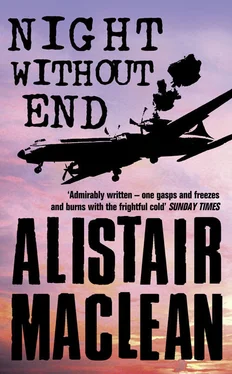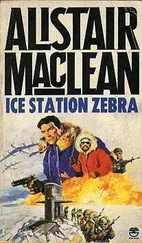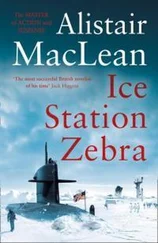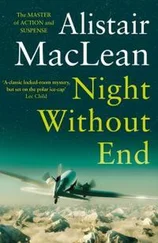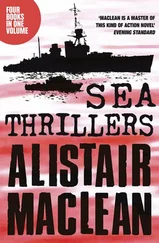We struck off to the north, with the wind on our right cheeks – I had no option but to gamble on the hope that the wind had neither backed nor veered – our torches probing the ground in front of us, stopping every fifteen or twenty feet to drive a pointed bamboo marker into the frozen ground. We had covered fifty yards without sighting anything, and I was just beginning to become convinced that we must still be well to the west of the plane’s touchdown point and wondering what in the world we should do next when we almost literally stumbled into an eighteen inch deep, ten foot wide depression in the snow-crust of the ice-cap.
This was it, no question about that. By a one in a hundred chance we had hit on the very spot where the plane had touched down – or crashed down, if the size of the depression in that frozen snow were anything to go by. To the left, the west, the ground was virginal, unmarked – ten feet to that side and we should have missed it altogether. To the east, the deep depression shelved rapidly upwards, its smooth convexity now marred by two large gouge marks, one in the centre and one to the right of the track, as if a pair of gigantic ploughs had furrowed through the ground: part of the under fuselage must have been ripped open by the impact – it would have been a wonder had it not been. Some way farther to the east, and well to the right of the main track, two other grooves, parallel and of a shallow bowl shape, had been torn in the snow. The gouge marks, plainly, of the still-racing propellers: the plane must have tilted over on its right wing just after the moment of landing.
To see all this took no longer than to sweep a torch through a swift semi-circle. I shouted to Joss to take another bundle of canes and prop up the homing spool line that led back to the antenna – if this weren’t done it would drift over and be lost to sight in ten minutes – and then rejoin us: then I turned and ran after Jackstraw who had already urged his team forwards and eastwards along the track of the crashed plane.
The wind was worse than ever, the drift an almost solid wall that reduced our speed to a lurching stumble and forced us to lean far into it to maintain our balance. Two hundred yards, three hundred, and then, almost a quarter of a mile from where it had touched down we found the airliner simply by walking straight into it. It had slewed almost 90 degrees as it had come to a halt, and was lying square across its own path, still resting on even keel.
In the feeble light of my torch the airliner, even although its fuselage rested on the ground, seemed immensely high and to stretch away for a vast distance on either side, but for all its great size there was something peculiarly pathetic and forlorn about it. But this, of course, was purely subjective, the knowledge in my own mind that this crippled giant would never leave here again.
I could hear no movement, see no movement. High above my head a faint blue light seemed to glow behind some of the cabin windows but apart from that there was no sign of life at all.
Конец ознакомительного фрагмента.
Текст предоставлен ООО «ЛитРес».
Прочитайте эту книгу целиком, купив полную легальную версию на ЛитРес.
Безопасно оплатить книгу можно банковской картой Visa, MasterCard, Maestro, со счета мобильного телефона, с платежного терминала, в салоне МТС или Связной, через PayPal, WebMoney, Яндекс.Деньги, QIWI Кошелек, бонусными картами или другим удобным Вам способом.
